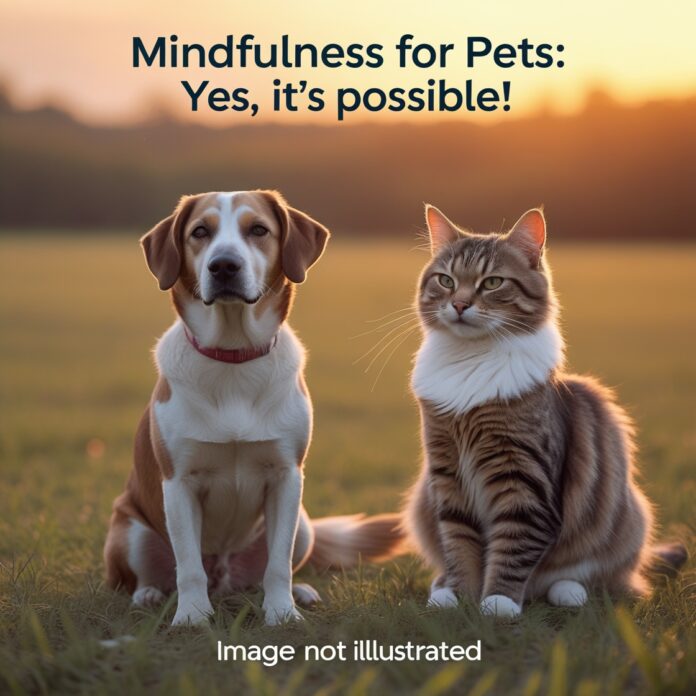Have you ever thought about how mindfulness can help your pet? 🐾 It might sound surprising, but mindfulness for pets is not only possible—it’s becoming increasingly popular among pet owners who want to enhance their companions’ well-being. In a world full of stressors, even our four-legged friends can experience anxiety and tension. This is where mindfulness can help, providing a way to balance and calm for both humans and pets.
Imagine creating a serene oasis for your pet, where stress melts away and contentment reigns supreme. From mindful feeding practices to calming grooming sessions, there are numerous ways to incorporate mindfulness into your pet’s daily routine. But how exactly does one practice mindfulness with a cat, dog, or even a rabbit? 🐱🐶🐰 In this web journal article, we’ll investigate the intriguing field of pet mindfulness and share techniques that can upgrade your bond together with your creature companion and raise their level of happiness.

Join us as we delve into the art of understanding your pet’s needs, recognizing signs of stress, and creating a harmonious environment that nurtures their well-being. We’ll guide you through mindful practices for feeding, petting, and playtime, as well as share meditation techniques that can benefit both you and your pet. Prepare yourself for a voyage of self-discovery as you learn how to overcome obstacles and develop a closer, more thoughtful bond with your cherished pet.
Understanding Mindfulness for Pets
Definition of pet mindfulness
Pet mindfulness involves being fully present and attentive to your pet’s needs, emotions, and behaviors. Focused, nonjudgmental awareness is the key to developing a stronger bond with your animal partner. This practice helps reduce stress for both pets and owners, fostering a more harmonious relationship.
Benefits for both pets and owners
Practicing mindfulness with pets offers numerous advantages:
- Reduced anxiety and stress
- Improved emotional well-being
- Enhanced bond between pet and owner
- Better understanding of pet’s needs
| Benefits for Pets | Benefits for Owners |
|---|---|
| Decreased anxiety | Lowered blood pressure |
| Improved behavior | Reduced stress levels |
| Better sleep | Increased empathy |
Recognizing Signs of Stress in Pets
Common stress indicators in dogs
- Excessive barking or whining
- Pacing or restlessness
- Destructive behavior
- Loss of appetite
Dogs often display stress through body language. Watch for:
| Body Part | Stress Signal |
|---|---|
| Ears | Pinned back |
| Tail | Tucked under |
| Eyes | Whale eye |
| Mouth | Yawning |
Stress signals in cats
Cats are masters of subtle communication. Look for:
- Excessive grooming or hair loss
- Changes in litter box habits
- Hiding more than usual
Creating a Calm Environment
Designating a quiet space
Setting aside a peaceful area is the first step in creating a peaceful atmosphere for your pet. Choose a low-traffic area in your home, away from noisy appliances and busy areas. Set up a comfortable bed or blanket, and add familiar toys to make it inviting.
Using soothing sounds and music
Incorporate calming sounds or soft music to enhance relaxation. Consider using:
- Nature sounds (ocean waves, rainfall)
- Classical music
- White noise machines
Mindful Feeding Practices
Slow feeding techniques
Slow feeding techniques can significantly enhance your pet’s mealtime experience. Consider these methods:
- Use puzzle feeders or slow-feeder bowls
- Scatter dry food on a snuffle mat
- Divide meals into smaller portions
- Hand-feed occasionally for bonding
| Technique | Benefits |
|---|---|
| Puzzle feeders | Mental stimulation, slows eating |
| Scatter feeding | Encourages natural foraging behavior |
| Multiple small meals | Aids digestion, prevents overeating |
Incorporating puzzle feeders
While slowing down eating, puzzle feeders stimulate the mind. They can be anything from basic mazes to intricate interactive toys. Regular use can:
- Reduce boredom and anxiety
- Prevent digestive issues from rapid eating
- Enhance problem-solving skills

Mindful Petting and Grooming
Gentle touch techniques
- Slow, deliberate strokes
- Light pressure
- Circular motions
Incorporating breathing exercises
In addition to lowering stress levels for both of you, mindful pet care can strengthen your relationship with your pet. Use techniques for gentle touch, such as moderate strokes and light pressure. By synchronizing your breath with your pet’s, you can incorporate breathing exercises. This improves the bonding process and fosters a peaceful environment.
Mindful Play and Exercise
Engaging in focused playtime
- Choose interactive toys
- Set aside dedicated playtime
- Observe your pet’s reactions
| Playtime Benefits | For Pets | For Owners |
|---|---|---|
| Mental stimulation | ✓ | ✓ |
| Physical exercise | ✓ | ✓ |
| Bonding | ✓ | ✓ |
Practicing outdoor mindfulness walks
A special chance to bond with your pet and the natural world is provided by mindful walks. Focus on your pet’s movements, the environment, and your own sensations. This practice enhances the bond between you and your furry friend while reducing stress for both.
Meditation Techniques for Pet Owners
Visualizing a peaceful pet experience
Imagine a serene scene with your pet, focusing on their contentment and relaxation. This visualization technique can help reduce your stress and enhance your bond.
Practicing gratitude for your pet
Think about how happy your pet makes you. This practice improves your general well-being and fosters a deeper bond with your pet.
Overcoming Challenges in Pet Mindfulness
Dealing with easily distracted pets
- Strategies for keeping pets focused:
- Use high-value treats
- Start with shorter sessions
- Choose quiet environments
- Utilize calming scents
Adapting practices for different pet personalities
| Personality Type | Mindfulness Approach |
|---|---|
| Energetic | Active meditation |
| Anxious | Gentle touch therapy |
| Independent | Passive observation |
Tailoring mindfulness practices to your pet’s unique personality is crucial. For energetic pets, incorporate movement-based exercises. On edge creatures may be calmed by calming procedures and calming touch. Independent pets might respond better to passive observation exercises, allowing them to engage at their own pace.
We may develop a deeper, more meaningful relationship with our pets and enhance their overall welfare by practicing mindfulness. By understanding stress signals, creating a peaceful environment, and engaging in mindful feeding, petting, grooming, and play, we can significantly improve our pets’ quality of life. By incorporating meditation techniques into our daily routines, we can also become more perceptive of our pets’ needs and emotions.

As you embark on your pet mindfulness journey, remember that patience and consistency are key. Start small, celebrate progress, and be open to adjusting your approach based on your pet’s unique personality and preferences. By cultivating a mindful relationship with your furry companion, you’ll not only enhance their happiness and health but also experience the joy and tranquility that comes from living in the present moment together.



